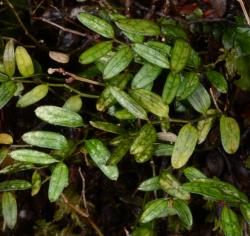- Taxon
- Gallery
- = Callixene parviflora Hook.f., Icon. Pl. 7, t. 632 (1844)
- ≡ Enargea parviflora (Hook.f.) Skottsb. (1915)
- = Callixene melantha Colenso, Trans. & Proc. New Zealand Inst. 17: 250 (1884 [1885])
Wiry, low-growing, semi-herbaceous perennial. Stem creeping at base, occ. 50 cm. long; internodes 2–4–(6) cm. long; nodes with scarious scales and short roots, giving off arcuate aerial branching twigs 4–25 cm. long; lower nodes of each branch with a brown scale in place of a lf, the lowest scale us. shortly tubular; new branches arising mostly in axils of these scales, rarely from axils of green lvs. Stem 4-angled, c. 1 mm. diam., the lvs alternate and distichous in zigzag pattern; each twig of limited growth with 4–12 green lvs, at intervals of 4–10–(20) mm., the uppermost internode so short that the last 2 lvs appear opp. Lvs 7–27 × 3–6–(10) mm., ± oblong, very shortly apiculate; margin entire; petiole very short and twisted so that the smooth, green, slightly keeled abaxial surface faces up to the light (resupinate); adaxial surface ± concave, the spaces between the main nerves notably pale and less smooth; 1–2 nerves on each side of midrib connected by several irregular, ± obvious transverse veins. Fls solitary and terminal between paired uppermost lvs; occ. 1 or 2 of next lower lvs also subtending fls. Fl.-bud, protected by c. 3 scale lvs, rests all winter before the pedicel elongates to 3–5 mm., and fl. develops and opens. Per. nodding; tepals c. 8–18 mm. long, opaque white; outer tepals c. 3 mm. wide with one mid-vein giving off side branches; inner tepals slightly wider, with band of 3 main veins, the mid-vein unbranched. Stamens much < tepals; filaments barely = ovary, little flattened, narrowed above; anther dorsifixed just below middle, versatile but mostly standing erect. Ovary 2.5 mm. long; style 2.5 mm.; ovules 2–3 per locule. Fr. c. 1 cm. diam., sub-globose, shortly apiculate, white, fleshy. Seeds c. 2.5 × 2 mm., pale, very hard. 2n = 20.
[From: Moore and Edgar (1970) Flora of New Zealand. Volume 2.]
Flowering: Dec.–Mar.; Fruiting: Jan.–Dec.




